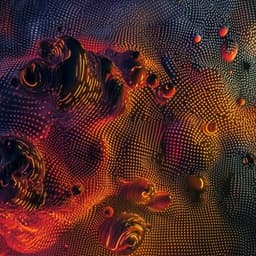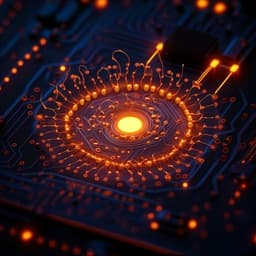
Physics
Al-enabled Lorentz microscopy for quantitative imaging of nanoscale magnetic spin textures
A. R. C. Mccray, T. Zhou, et al.
Discover the groundbreaking SIPRAD method by Arthur R. C. McCray and colleagues, revolutionizing quantitative phase reconstruction in nanoscale magnetic imaging. This AI-driven approach excels in accuracy and noise robustness, providing real-time insights into magnetic spin textures with unprecedented clarity.
~3 min • Beginner • English
Introduction
Magnetic spin textures such as skyrmions are promising information carriers for novel computing paradigms due to their mobility, stability, and rich interfacial physics. Real-space, nanoscale imaging under external stimuli (temperature, magnetic/electric fields, current) is essential to understand and control their behavior. LTEM affords simultaneous observation of magnetic domains and microstructure and supports in situ experiments. The magnetic information is encoded in the phase of the electron wave (Aharonov–Bohm effect), where the total phase is the sum of electrostatic and magnetic components; isolating the magnetic phase enables quantitative in-plane integrated magnetic induction mapping. Conventional phase retrieval via the transport of intensity equation (TIE) uses a through-focal series but sacrifices spatial and phase resolution at practical defocus values. Alternatives like off-axis holography and 4D-STEM impose hardware and acquisition burdens that are often incompatible with in situ studies. Single-image TIE (SITIE) can work in limited cases but assumes small defocus and purely magnetic contrast, making it highly susceptible to noise and nonmagnetic contrast from diffraction, thickness variations, or surface contamination. This motivates a robust single-image, quantitative phase reconstruction approach suitable for realistic, noisy, heterogeneous samples and in situ acquisition constraints. The work introduces SIPRAD, a single-image phase reconstruction via automatic differentiation combined with deep image priors and a physics-based LTEM forward model, to robustly recover the magnetic phase and separate it from electrostatic/amplitude contributions.
Literature Review
Prior approaches for LTEM phase retrieval include: (1) TIE, which relates phase to a through-focal image stack and is straightforward but exhibits reduced spatial/phase resolution at higher, experimentally common defocus. (2) Off-axis electron holography enables high-resolution phase maps but requires a biprism and reference wave, limiting applicability. (3) 4D-STEM/ptychography provides high-resolution phase but needs long measurements and specialized detectors. (4) Recent automatic differentiation with forward modeling has improved total phase reconstruction from multi-image TFS compared to TIE. (5) SITIE reconstructs phase from a single defocused image under small-defocus and homogeneous-object assumptions, but it is sensitive to noise and nonmagnetic contrast (diffraction, thickness, contamination), often necessitating filters (e.g., Tikhonov) that compromise quantitative accuracy. These limitations underscore the need for a single-image, noise-robust, and heterogeneity-aware method, which SIPRAD addresses by combining a forward LTEM image formation model with deep image priors for regularization and separation of magnetic and electrostatic/amplitude effects.
Methodology
SIPRAD framework: A physics-informed, automatic differentiation (AD) reconstruction uses a single defocused LTEM image and known microscope parameters within a linear Fresnel imaging forward model. A deep image prior (DIP), implemented as a convolutional autoencoder in PyTorch and optimized via Adam, generates the magnetic phase map φ_m. Optionally, a second DIP generates a spatially varying amplitude map to model sample heterogeneities and associated electrostatic phase contributions.
Inputs and initialization: The phase DIP is seeded with an approximate phase obtained via SITIE to accelerate convergence. The amplitude DIP (when enabled) receives a thresholded version of the input image to isolate surface contaminants or heterogeneities and is constrained to a dual-valued form (uniform background plus contaminant regions) enforced periodically during optimization.
Forward LTEM image model: The exit wave ψ(r_t)=α(r_t) exp[iφ(r_t)], with α the amplitude (accounting for absorption via α=exp(-t_t/ξ_0)) and φ the total phase (φ=φ_e+φ_m). The simulated image is I(r_t)=|ψ*T|^2 where T(k)=A(k) exp[-iχ(k)] exp[-g(k)] comprises the objective aperture A, phase transfer function χ(k)=πλ[Δz + C_1 cos(2ψ) |k|^2 + C_s λ |k|^4] (with defocus Δz, astigmatism magnitude/orientation, spherical aberration C_s), and a damping envelope exp[-g(k)] including beam divergence θ_e and defocus spread Δ. The model is evaluated in Fourier space. Magnetic induction B_⊥ is obtained from gradients of φ_m.
Optimization: The simulated image from the forward model is compared to the experimental input using mean squared error; gradients are backpropagated to update DIP weights. Data augmentation adds small noise to the input during training. Each DIP is pre-trained for 200 iterations to reproduce its input before joint optimization. Early stopping is used to avoid overfitting, especially with amplitude reconstruction. The reconstructed φ_m is lightly smoothed (Gaussian σ=2 pixels). Typical convergence for a 512×512 image requires ~5000 iterations (~35 s on an NVIDIA A100 GPU).
Amplitude and electrostatic separation: When amplitude heterogeneity is present (e.g., surface contaminants), the amplitude DIP output is used directly in the forward model and scaled by material parameters to estimate the local electrostatic phase φ_e from the same features, which is then added to φ_m to form the total phase input to the forward model. The amplitude branch is constrained to be dual-valued and periodically thresholded to enhance stability.
Accuracy studies and datasets: Accuracy was quantified across defocus (−0.1 to −8 mm) and Gaussian noise levels (0% to 300%) by averaging results over 10 random-noise realizations per condition. Simulated magnetization configurations (stripe and bubble domains) in CGT were generated with Mumax3; PyLorentz computed phase and LTEM images, with Gaussian noise added post hoc. Experimental data: Cryo-LTEM of exfoliated CGT (150 nm thick) on SiN membrane, JEOL JEM-2100F with Gatan double-tilt He holder; sample field-cooled to 23 K in 500 Oe, defocus around −700 µm for bubble domains and for in situ cooling series. For challenging experimental images, a fixed amplitude map was derived by manual thresholding of the input image to stabilize φ_m-only optimization. Baselines: SITIE and TIE (using a three-image TFS at Δz=±700 µm and 0) were implemented with PyLorentz for comparison.
Key Findings
- SIPRAD reconstructs the magnetic phase φ_m and in-plane integrated magnetic induction from a single defocused LTEM image with significantly higher accuracy and noise robustness than SITIE across practical defocus ranges.
- In simulated stripe domains, SIPRAD accurately recovers domain wall positions and widths, outperforming SITIE which misplaces and broadens walls due to its assumptions. Even with 50% Gaussian noise, SIPRAD maintains high phase and induction accuracy, whereas SITIE degrades sharply.
- Parameter-space benchmarking (defocus −0.1 to −8 mm; noise 0–300%): SIPRAD phase accuracy remains high over a broad region, particularly at experimentally relevant larger defocus (≥ −1 mm). Induction accuracy is robust up to large defocus (≈ −3 mm) and high noise (approaching 100%), decreasing mainly at extreme defocus due to image blurring. SITIE is accurate only for low defocus and low noise.
- SIPRAD separates magnetic phase from nonmagnetic contrast due to amplitude/electrostatic variations (e.g., surface contamination). In simulations with contaminants, SIPRAD correctly reconstructs φ_m and amplitude maps and recovers B_⊥ except near occluded regions; SITIE yields erroneous phase scale and induction dominated by contaminant artifacts even with optimized Tikhonov filtering.
- Experimental CGT bubble domains: With a fixed, threshold-derived amplitude map, SIPRAD yields φ_m and B_⊥ maps that better represent true domain structures than SITIE and even TIE from a 3-image TFS, reducing artifacts from surface particles. Artifacts persist near contaminants and image edges (periodic boundary conditions).
- In situ field-cooling series: SIPRAD enables quantitative, frame-by-frame magnetic phase reconstruction from single images, tracking bubble rearrangement, disappearance, and lattice distortions despite bend contours and noise.
- Practical performance: ~5000 iterations (~35 s) per 512×512 image on an NVIDIA A100 GPU; accurate phase up to ≈ −6 mm defocus and B_⊥ up to ≈ −3 mm in tested scenarios.
Discussion
The study addresses the critical need for quantitative, single-image LTEM phase reconstruction suitable for in situ experiments where through-focal series or complex instrumentation are impractical. By coupling a physics-based LTEM forward model with deep image priors, SIPRAD regularizes the ill-posed single-image inversion, yielding accurate φ_m even at large defocus and high noise typical of experimental conditions. The ability to incorporate and disentangle amplitude/electrostatic contributions from magnetic contrast directly tackles a major failure mode of SITIE and limits of TIE-based approaches in heterogeneous samples. Consequently, SIPRAD enables reliable extraction of domain wall positions, widths, and integrated induction maps necessary for quantitative magnetic materials analysis. The method’s robustness to noise allows shorter exposure times (beneficial for beam-sensitive materials) and supports time-resolved in situ studies by reconstructing individual frames while accommodating evolving imaging conditions and emergent surface features. Although per-image optimization is slower than pretrained inference, the reconstruction time is practical for integration into data-processing workflows and near real-time analysis pipelines.
Conclusion
This work introduces SIPRAD, a single-image, AD-driven LTEM phase reconstruction method regularized by deep image priors and grounded in a forward imaging model. SIPRAD delivers superior accuracy and noise robustness over SITIE across realistic defocus ranges, and, crucially, separates magnetic phase from amplitude/electrostatic heterogeneities in both simulations and experiments. It enables quantitative analysis of spin textures in conditions where TIE or holography are infeasible, such as in situ, high-defocus, and noisy acquisitions. Future directions include extending amplitude/electrostatic modeling beyond dual-valued constraints to more complex heterogeneities (e.g., local potential variations or bend contours), integrating additional prior knowledge (e.g., sample topography) into the forward model, further stabilizing joint amplitude–phase optimization at high noise, and optimizing implementations for faster, near real-time reconstructions during in situ experiments.
Limitations
- Joint reconstruction of amplitude and magnetic phase from a single noisy image can be unstable and may diverge; often a fixed, threshold-derived amplitude map is needed for stability.
- Artifacts persist near strong surface contaminants and at image boundaries due to periodic boundary conditions, and magnetic information under contaminants may be unrecoverable.
- Dependence on accurate microscope parameters (defocus, aberrations, envelopes) and manual thresholding to isolate contaminants can introduce user dependency.
- The DIP-based optimization is slower than feed-forward inference; each image requires per-instance optimization, which, while practical, is not real-time for high-throughput scenarios.
- Accuracy of B_⊥ declines at very large defocus due to image blurring; extreme noise or nonmagnetic contrast not captured by the amplitude/electrostatic model can challenge reconstruction.
Related Publications
Explore these studies to deepen your understanding of the subject.







